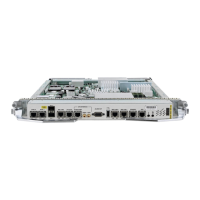PIM Shared Tree and Source Tree (Shortest Path Tree)
In PIM-SM, the rendezvous point (RP) is used to bridge sources sending data to a particular group with
receivers sending joins for that group. In the initial setup of state, interested receivers receive data from senders
to the group across a single data distribution tree rooted at the RP. This type of distribution tree is called a
shared tree or rendezvous point tree (RPT) as illustrated in Figure 3: Shared Tree and Source Tree (Shortest
Path Tree), on page 11 . Data from senders is delivered to the RP for distribution to group members joined
to the shared tree.
Figure 3: Shared Tree and Source Tree (Shortest Path Tree)
Unless the spt-threshold infinity command is configured, this initial state gives way as soon as traffic is
received on the leaf routers (designated router closest to the host receivers). When the leaf router receives
traffic from the RP on the RPT, the router initiates a switch to a data distribution tree rooted at the source
sending traffic. This type of distribution tree is called a shortest path tree or source tree. By default, the
Cisco IOS XR Software switches to a source tree when it receives the first data packet from a source.
The following process describes the move from shared tree to source tree in more detail:
1
Receiver joins a group; leaf Router C sends a join message toward RP.
2
RP puts link to Router C in its outgoing interface list.
3
Source sends data; Router A encapsulates data in Register and sends it to RP.
4
RP forwards data down the shared tree to Router C and sends a join message toward Source. At this point,
data may arrive twice at the RP, once encapsulated and once natively.
5
When data arrives natively (unencapsulated) at RP, RP sends a register-stop message to Router A.
Cisco ASR 9000 Series Aggregation Services Router Multicast Configuration Guide, Release 5.1.x
11
Implementing Layer-3 Multicast Routing on Cisco IOS XR Software
PIM Shared Tree and Source Tree (Shortest Path Tree)

